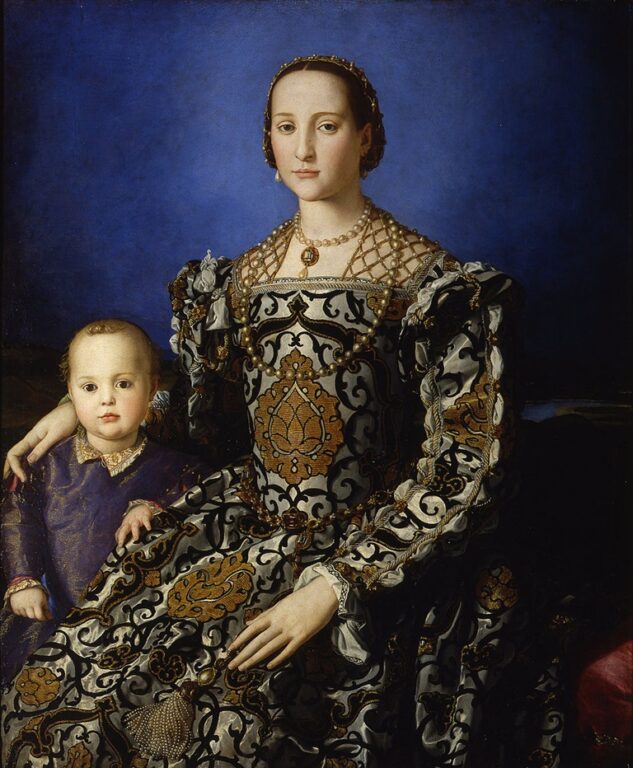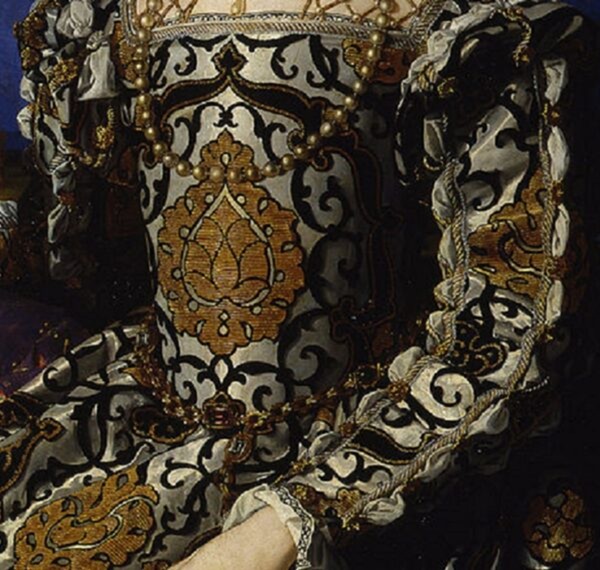“We are rich and in charge, and if our clothes break the sumptuary laws, so what?”
The Watermill’s bedrooms are named after famous Italian artists* and we thought it would be fun to tell you more about them in a series of short articles. We’ll also make sure that there’s a copy of their stories in their bedrooms here, for you to enjoy during your stay.
Today it’s the turn of Agnolo di Cosimo, better known as Bronzino (1503-1572). Here’s his magnificent portrait of Eleonora di Toledo and her son Giovanni de’ Medici, painted around 1545.

Agnolo Bronzino, Eleonora di Toledo and her son Giovanni de’ Medici. The Uffizi Gallery, Florence. Public domain: Google Art Project via Wikimedia Commo
Some years ago, when Bill first saw this portrait, he thought Eleanora looked rather sad, and the adjectives aloof and disdainful also sprang to mind. Not the sort of girl with whom you have fun enjoying an evening aperitivo. And her young son doesn’t look much friendlier, staring solemnly at us. Then he realised the painting has little to do with Eleanora or Giovanni. It is all about – the dress. And showing off. Not just Bronzino showing off his wonderful technique, but the Medici (Eleanora is married to Cosimo I de’ Medici, Grand Duke of Tuscany) telling the world who’s boss. The dress is an in-your-face symbol of power: “We are rich and in charge, and if our clothes break the sumptuary laws, so what?” The dress is of heavily brocaded silk velvet with black arabesques intertwined with gold looped strands, all painstakingly reproduced by Bronzino, as can be seen in the close-up photograph below. [It has been suggested, incidentally, that the gold belt, adorned with jewels, was made by Benvenuto Cellini.]

Agnolo Bronzino, Eleonora di Toledo (detail). The Uffizi Gallery, Florence. Google Art Project via Wikimedia Common
You can see why Bronzino got the job of court painter. The background, for example, is not simply a plain, polychromatic blue. There are subtle variations in shade, and the blue around Eleonora’s head is lighter, creating an effect rather like a halo, suggesting that the grand duke and his wife were divinely blessed, all part of the process of maintaining and enhancing Medici power. The painting is full of symbols: it is not just the sumptuous dress as an expression of wealth and power: its pomegranate motif symbolises fertility, while Eleanora’s arm on her son’s shoulder demonstrates the continuity of the Medici line.
Eleanora and Cosimo were married in 1537, when she was 17, and his attraction to her is shown by the fact that he turned down a larger dowry for her elder sister. Their loving domesticity was an example to all, and Eleanora had no fewer than 11 children by Cosimo. He was heartbroken over her death from malaria in 1562, and soon after he retired from public life, his son Francesco de’ Medicion becoming Regent. To be fair to Eleanora, I’m sure she was friendlier in the flesh than in the portrait, which, painted in the Mannerist style, which rejected naturalism and required those emotionless gazes.
But enough of the Medici, who seem to take over everything, given half the chance. We are supposed to be talking about the artist!
Bronzino lived all his life in Florence and his nickname may refer to a relatively dark skin or to his reddish hair. He trained under Jacopo Pontormo, one of the early exponents of the Mannerist school, which also included Michelangelo and Leonardo da Vinci. Bronzino’s graceful and elongated figures, however, often seen cold, composed and reserved, unlike the emotional, active and often agitated subjects of his Master.
As well as portraits, Bronzino also painted religious subjects and the occasional allegory, such as Venus, Cupid, Folly and Time (1544/5).

Angolo Bronzino, Venus, Cupid, Folly and Time, National Gallery, London. Public domain, via Wikimedia Commons.
Portraits, however, were the mainstay of Bronzino’s studio, many existing in several versions, painted by the Master and/or his assistants/apprentices. Cosimo used then as gifts for visiting dignitaries or sent them out to help cement diplomatic alliances and agreements. Bronzino’s studio was the Production House for Cosimo’ spower-seeking Public Relations campaign.
Angolo Bronzino, Portrait of Cosimo I de’ Medici in armour. The Uffizi Gallery, Florence. Google Art Project via Wikimedia Commons.
I guess in this instance Eleanora might not have wanted to get too close for a hug!
*Who wants a number on the bedroom door when they could be staying in Botticelli, Bronzino or Brunelleschi? Or Gentileschi, Ghirlandaio or Ghiberti? Or one of another half-dozen famous Italian artists, from Alberti to Vasari?
Some years ago we decided to switch from numbers to names in each of our rooms, They celebrate famous Italian artists, mainly from the Renaissance and mainly men, because (a) the early Renaissance is our favourite artistic period and (b) because few women were painting professionally in those days, and even fewer have become famous. At Lois’ insistence we included Artemesia Gentileschi on our list, and next year we will be introducing Sofonisba Anguissola, despite her tongue-twisting name.
Look out for more stories about the artists

